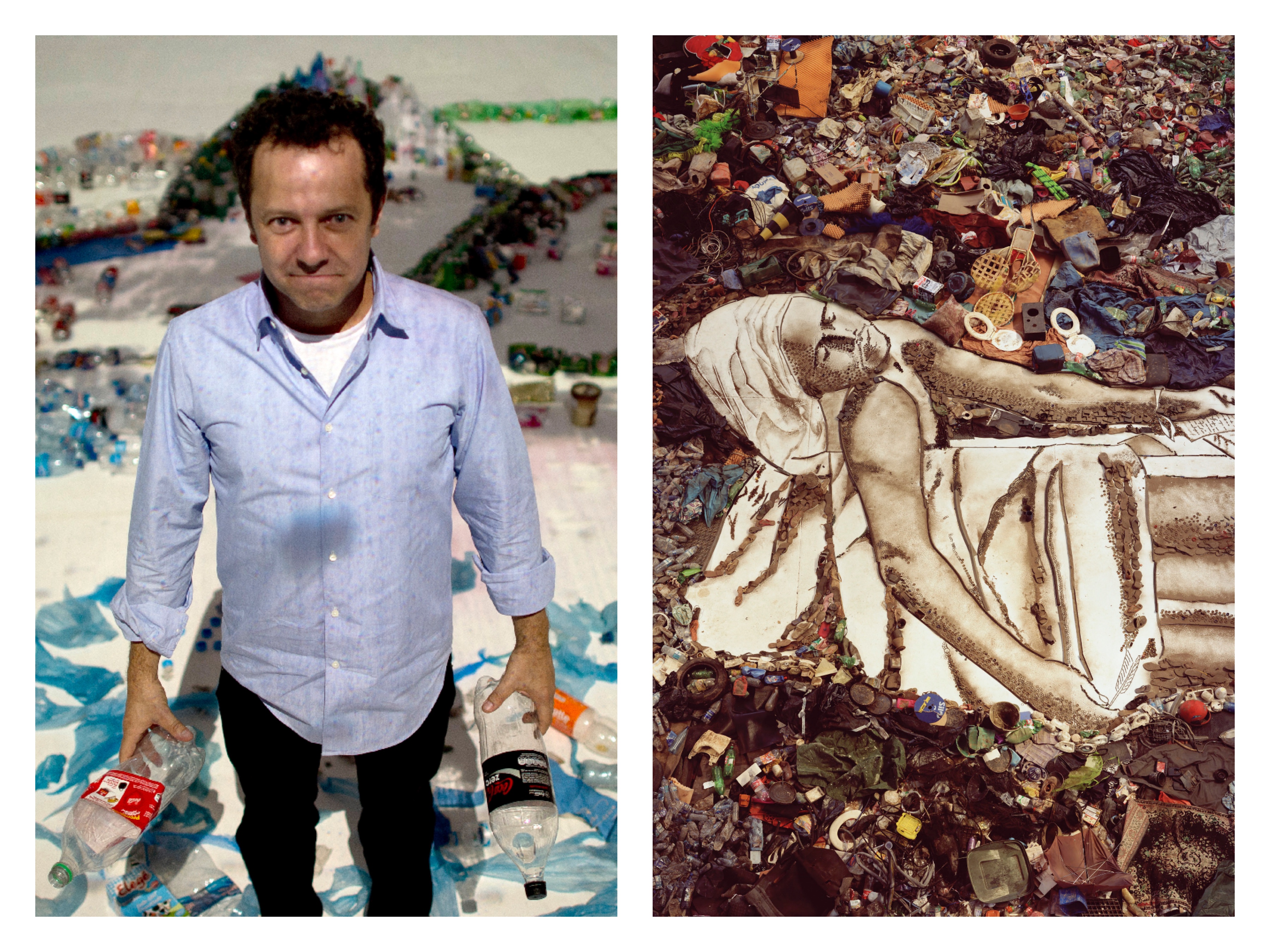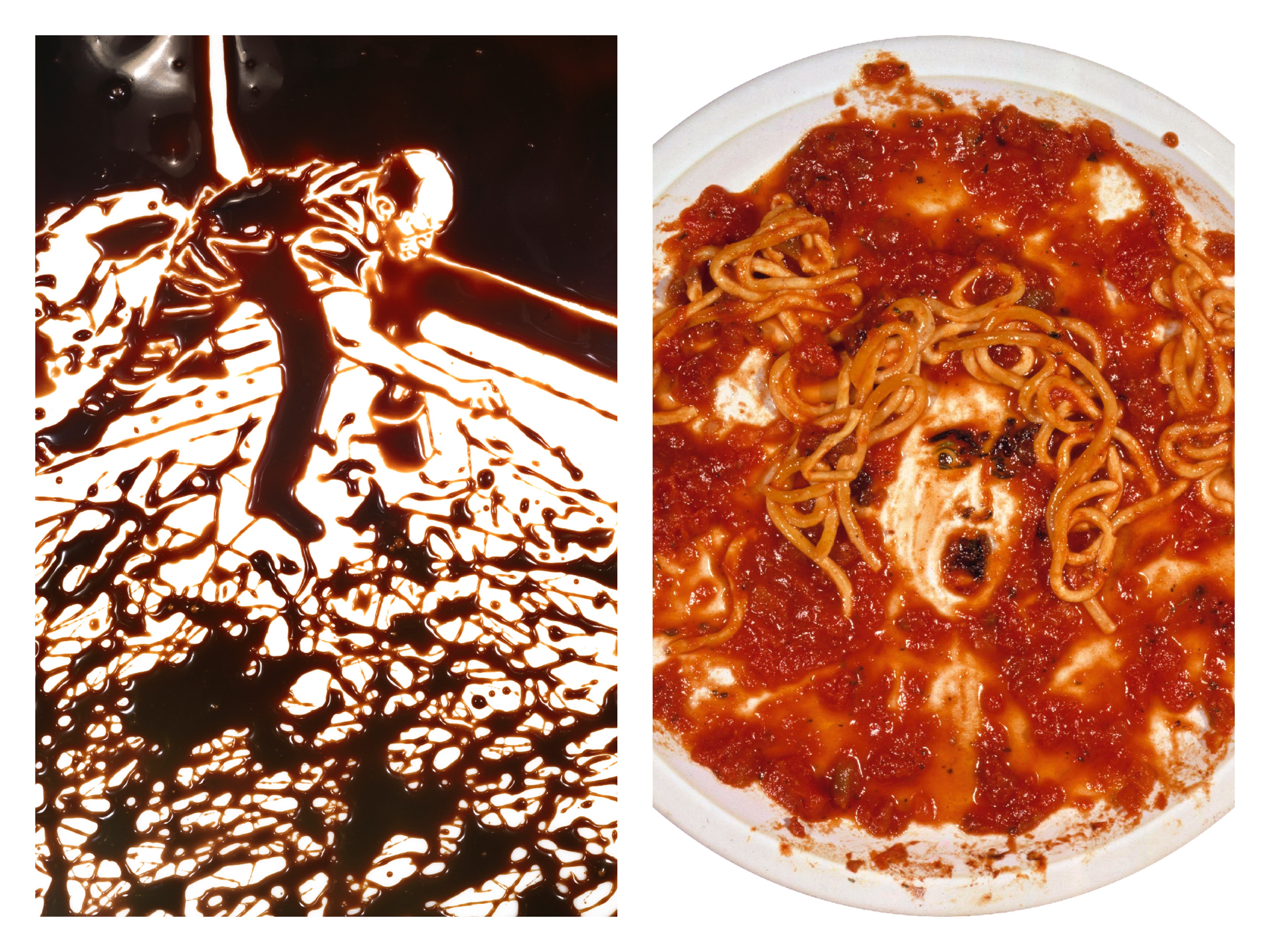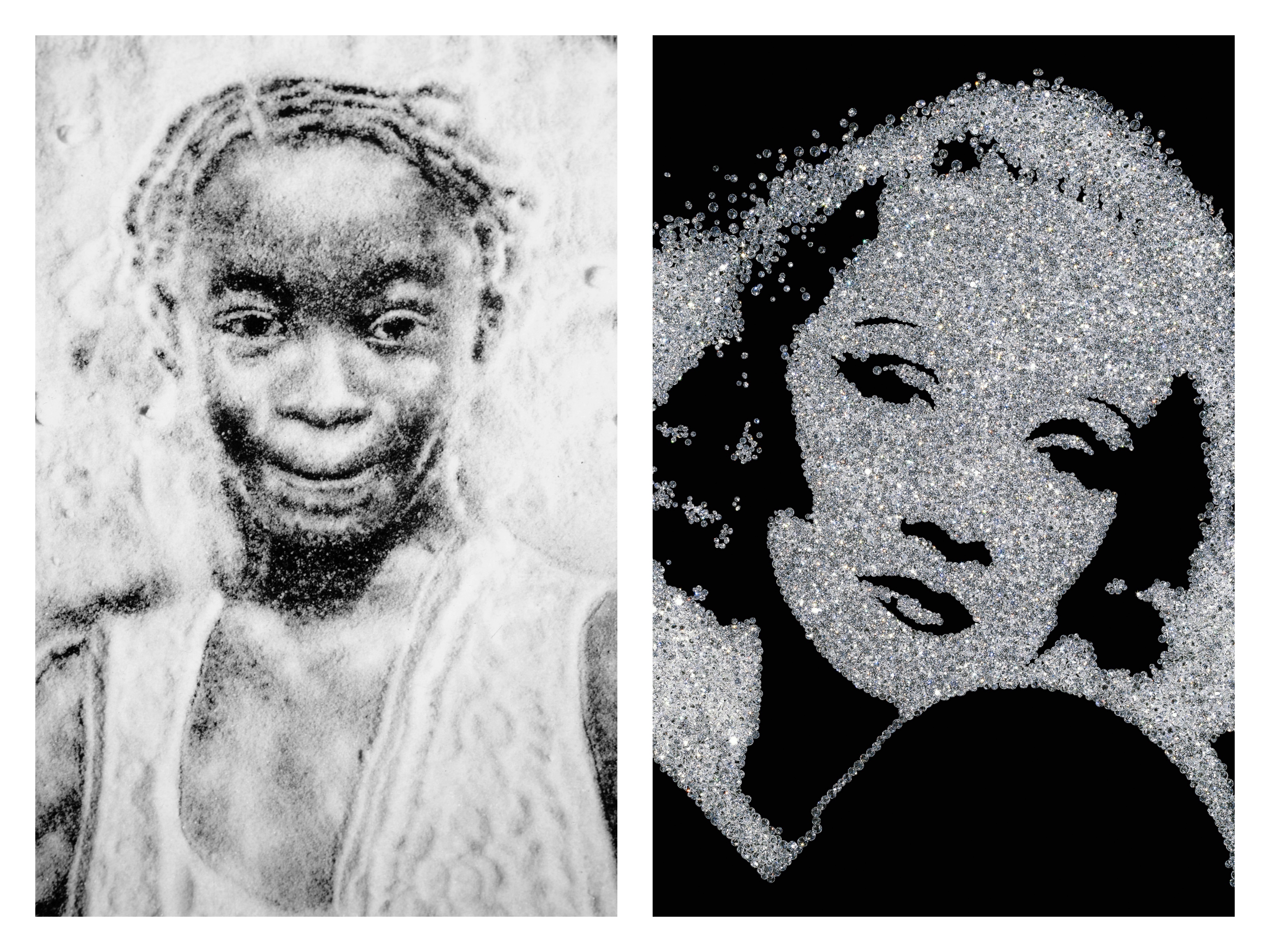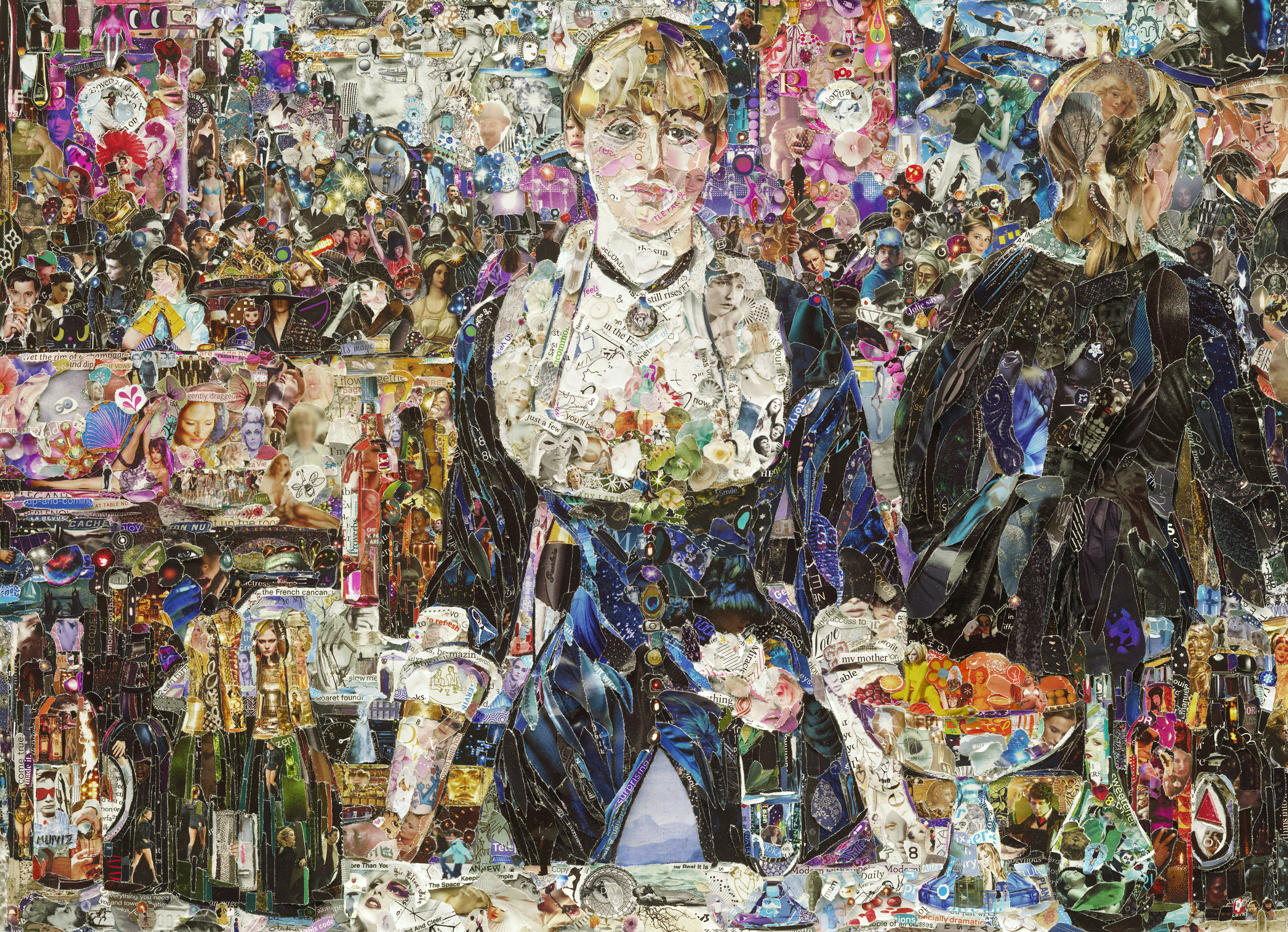This Artist Recreates Iconic Images Out of Trash, Toys, and Chocolate Syrup
Brazilian artist Vik Muniz isn’t like most photographers, who aim to capture extraordinary moments as they appear in real life. He’s known for making iconic images out of wacky materials, like the Mona Lisa rendered in peanut butter and jelly or Manet’s A Bar at the Folies-Bergére collaged from magazine clippings, then photographing the end product. It’s artwork Muniz describes as “photographic delusions” that playfully toy with our sensory memories and inspire a sense of wonder.
His work can be amusing as well as poignant, as noted in his series Pictures of Garbage from the award-winning documentary Waste Land (2010), which follows Muniz as he works with the catadores, or trash pickers, of Jardim Gramacho, a 321-acre dump near Rio de Janeiro that was the world’s biggest landfill before it closed in 2012. Muniz turned their trash into large-scale photographic portraits of the pickers, which he then sold at auction for $250,000, and gave the bulk of the proceeds back to the catadores union to build a library and retrain workers once the landfill closed.
A retrospective of Muniz’s massively diverse artwork, Vik Muniz: Photography and the Rebirth of Wonder , just opened at the Chrysler Museum of Art in Norfolk, Virginia. The exhibition and an accompanying monograph, Vik Muniz (Prestel), celebrate the dazzling marvels Muniz’ constructs out of things like diamonds, toys, chocolate syrup, and sand.
VICE caught up with Muniz while the artist was traveling in Italy to chat about how technology has liberated photography and how unexpected images can subvert and change the way we see the world.
VICE: How did your upbringing in Brazil inform how you create art?
Vik Muniz: When I was a teenager, you could not meet and discuss politics. The better-known expression of our culture during the military dictatorship was music, with composers like Caetano Veloso and João Gilberto. They are one generation older than mine, and they were doing a lot of political critiques disguised as love songs and pop songs.
I was not a direct victim of the military dictatorship, but I was a product of that environment. As a result I became very suspicious. Most of my friends were reading Karl Marx and political critiques. I was far more interested in Marshall McLuhan, information, and media. There were a lot of metaphors being thrown around. I was exposed to language that was very elastic, and you could feel how much you could bend information to suit your own interests. That created an imprint on my way of thinking and making art.

How does photography create a space for you to develop and test ideas that can only be constructed with a camera?
Photography has been the medium that has made the deepest connections between my mind and the outside world. For somebody who was born in Brazil, I had access to a lot of information but not any material goods; you get fed with the content of the images. You don’t travel, but you look at National Geographic. You see things you would love to have. Most of all, you learn about art from looking at reproductions.
I am lucky to be able to work with photography at this time in history. Photography, for nearly 200 years, was the place we chose to deposit our memories. With digital imaging, photography no longer can claim direct mechanical, unbiased relationship to reality. You can manipulate anything, and for that specific reason, digital imaging liberated photography from having to describe reality in the same way photography liberated painting from its relationship to the factual world.
For me, art is an evolving interface between mind and matter. We are trying to figure out a technique to understand the world. Understanding the world humanizes us; it makes us aware of the larger reality around us, of other cultures and other people. It’s a paradox that, in a time when we have all the information, many people are closing in on themselves—their families, their homes, their countries, their cities—and not seeing the whole planet as a unified [ecosystem] that we live in.

Could you speak about how the idea of “photographic delusions”?
A photograph is the ultimate delusion. It creates a vortex that leads you into another reality, another moment in time. It is almost as if we are looking at something that is happening right in front of our eyes; that is problematic. When you start toying with that and transplanting another layer of meaning or technical involvement, you force the viewer to rethink their relationship to the medium.
An image that is artistic inspires you to think about images: about what is in front of you and what you are looking at, about your relationship to it and the world. Conceptual art is normally just ideas, but I love the idea of being a conceptual artist that is involved with crafts. The process is very labor intensive. I like that because it draws your attention to all this retinal detail, mostly of a perceptual nature. That’s what will inspire the viewer in a meaningful experience. Ritualizing experience is what artists should be doing.
Something that is truly political is this: I want people to understand the world around them through the way they look at images. I want them to be more clear.

How do you select the works you plan to remake?
I try to keep things open. I am choosing images that are very familiar to the viewer, and I work with materials that most people have inside their kitchen that are easy to find. When you put these two things together you get something that’s quite magical. I think the artwork is done only when there is someone in front of it who has never seen it before.
I am drawn to the poster-store kind of iconography: you have seen this thing so many times that you look at it, but you don’t even pay attention because you have the arrogance of saying, “Oh I have seen this before.” Then you look at it and realize it’s not quite what you think it is, so you are forced to look at it again and this time with a lot more attention. That is primarily the reaction I am trying to provoke in most of my work.
You are going after different materials and processes. If I make drawings with earthworms, chocolate, or diamonds, that will put me in a situation where I will have to learn a lot about other things in order to produce this work. I have done things that are a mile long and things that are invisible to the naked eye. I am always trying to enlarge this atlas of different methods of what a presentation can be.
I love doing a retrospective because I learn a lot about what I am trying to do, which is not that clear. A large amount of it is instinctive, and you start realizing your motives for making it later, after the work is done.

In your book, you say “Artmaking, for me, is a quest for sanity.” This comes across with the creation of Waste Land. How did this project inspire you to reimagine how we deal with social issues of this magnitude?
I did a number of retrospective shows, and I realized that I really wanted to understand art’s true importance: what does it really do to people? There is the idea that art humanizes you; people exposed to inspiring artistic experiences tend to develop more empathy and a better understanding of others and the world around them. I truly believed that, but I had to prove that to myself.
I wanted to do a project that started with a very controlled environment—to be around people who had no experience of art, and expose them to an artistic experience that did not involve anything foreign to their reality so that they would make art with whatever they had around. I was trying to work in a garbage dump. The idea of pictures you don’t want to look at are very interesting to me.
It was a very lucky thing. The fact that it required a number of years to be completed gave it the tools for transformation of these individual lives; you become very drawn to them. More than that, I wanted to portray how similar and sensitive they are, and how they respond to art.
I did Waste Land to prove to myself of the importance of what I do as a professional. I really needed, at that point, to think of art and reinforce my beliefs in art—to prove to myself it is everything I thought it would be.
Sign up for our newsletter to get the best of VICE delivered to your inbox daily.
Follow Miss Rosen on Instagram.
This article originally appeared on VICE US.